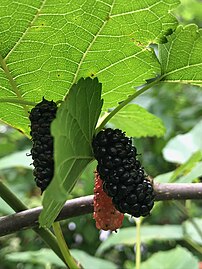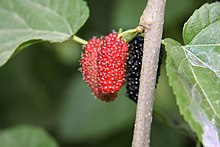
The Moraceae—often called the mulberry family or fig family—are a family of flowering plants comprising about 38 genera and over 1100 species. Most are widespread in tropical and subtropical regions, less so in temperate climates; however, their distribution is cosmopolitan overall. The only synapomorphy within the Moraceae is presence of laticifers and milky sap in all parenchymatous tissues, but generally useful field characters include two carpels sometimes with one reduced, compound inconspicuous flowers, and compound fruits. The family includes well-known plants such as the fig, banyan, breadfruit, jackfruit, mulberry, and Osage orange. The 'flowers' of Moraceae are often pseudanthia.

The sycamine tree is a tree mentioned in both classical Hebrew literature and in Greek literature. The tree is also known by the names sycamore fig tree, and fig-mulberry. It appears also in Luke 17:6 and 19:4 of the Bible. The Hebrew word for the tree is shiḳmah (sing.), shiḳmīn (pl.), having nearly the same phonemes in Greek Others, however, identify the tree as mulberry tree, found in two species, the Black Mulberry and the White Mulberry, which are common in Palestine. It is in the same family as the fig-tree.
The bricks are fallen, but we will build with hewn stones; the sycamores are cut down, but cedars will we put in their place.
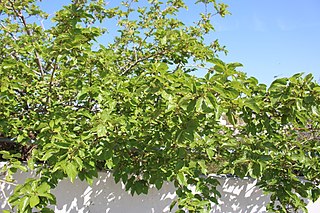
Morus alba, known as white mulberry, common mulberry and silkworm mulberry, is a fast-growing, small to medium-sized mulberry tree which grows to 10–20 m (33–66 ft) tall. It is generally a short-lived tree with a lifespan comparable to that of humans, although there are some specimens known to be more than 250 years old. The species is native to China and India and is widely cultivated and naturalized elsewhere.

Maclura tricuspidata is a tree native to East Asia, occasionally grown for its fruit, somewhat similar to that of the related mulberry. It is also known by common names including cudrang, kujibbong, storehousebush, mandarin melon berry, silkworm thorn, zhe or che, and Chinese mulberry. It grows up to 6 m high.
Chinese mulberry is a common name for several trees and may refer to:
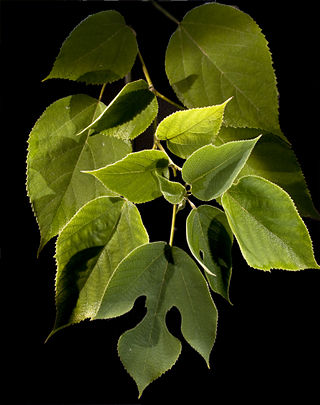
The paper mulberry is a species of flowering plant in the family Moraceae. It is native to Asia, where its range includes mainland China, Taiwan, Japan, Korea, Southeast Asia, Myanmar, and India. It is widely cultivated elsewhere and it grows as an introduced species in New Zealand, parts of Europe, the United States, and Africa. Other common names include tapa cloth tree.

Morus rubra, commonly known as the red mulberry, is a species of mulberry native to eastern and central North America. It is found from Ontario, Minnesota, and Vermont south to southern Florida, and west as far as southeastern South Dakota, Nebraska, Kansas, and central Texas. There have been reports of isolated populations in New Mexico, Idaho, and British Columbia.

Broussonetia is a genus of four species of trees in the family Moraceae, native to eastern Asia. These four species have high-quality fiber which consist of more than 90% of cellulose. They are traditionally applied for various daily necessities in South Eastern Asia and papermaking in East Asia.

Sambucus nigra is a species complex of flowering plants in the family Adoxaceae native to most of Europe. Common names include elder, elderberry, black elder, European elder, European elderberry, and European black elderberry. It grows in a variety of conditions including both wet and dry fertile soils, primarily in sunny locations. The plant is widely grown as an ornamental shrub or small tree. Both the flowers and the berries have a long tradition of culinary use, primarily for cordial and wine.
Morus serrata, known as Himalayan mulberry, is a species of mulberry native to the Himalaya and the mountains of southwestern China, at altitudes of up to 2,300 metres.
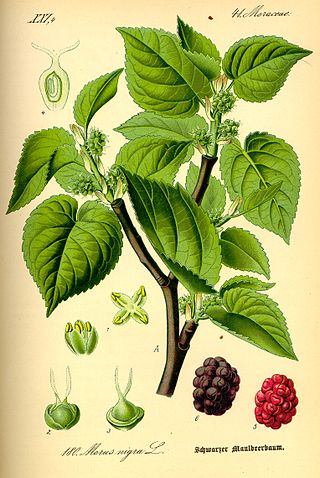
Morus nigra, called black mulberry, is a species of flowering plant in the family Moraceae that is native to southwestern Asia, where it has been cultivated for so long that its precise natural range is unknown. The black mulberry is known for its large number of chromosomes.

Moreae is a tribe within the plant family Moraceae. It includes 6–10 genera and 70–80 species, including Morus, the genus that includes the mulberries, and Maclura, the genus that includes the Osage orange.

Morus australis, also called Korean mulberry and Chinese mulberry, is a flowering plant species found in East and Southeast Asia.

Morus celtidifolia, the Texas mulberry, is a plant species native to South America, Central America, Mexico, and the southwestern United States, ranging from Argentina north as far as Arizona and Oklahoma. In the US, it grows in canyons and on slopes, usually near streams, from 200–2,200 metres in elevation. It is very often referred to as "Morus microphylla," including in Flora of North America, but recent studies suggest that these names are synonymous with M. celtidifolia holding priority.

The Mulberry garden, originally Morušová zahrada in Czech, is a cottage garden in the Czech Republic, situated in the Czech Central Uplands in the village Režný Újezd, 7 kilometres (4.3 mi) northwest of the town Lovosice. The garden was established in 2014 by local gardeners admiring the English cottage garden style. Apart from different kinds of plants such as perennial plants, English historical roses, Czech roses, annual plants, and bulbs, several uncommon fruit trees are grown, especially various mulberry varieties. Mulberry garden is located along the green tourist track to Boreč hill in the grounds of former Gentlemen's farm, house no. 2.

Morus indica is a member of the genus Morus, of the family of flowering plants Moraceae, commonly known as the mulberry family. As with other mulberries, Morus indica is a deciduous tree. Morus indica is native to the temperate and sub-tropical Himalayan region. It is currently cultivated in India, China, Japan, and East Africa.

Morus mongolica, also described as Morus alba var. mongolica, is a woody plant native to mountain forests in Mongolia, China, Korea, and Japan. Common names include Mongolian mulberry, meng sang (China), and ilama by native people in the namesake region of Mongolia. Similar to M. notabilis, M. mongolica is an uncultivated mulberry.







